The AMD Radeon R9 Nano Review: The Power of Size
by Ryan Smith on September 10, 2015 8:00 AM ESTOverclocking
Finally, no review of a high-end video card would be complete without a look at overclocking performance.
Of all of the Fiji cards overclocking the R9 Nano is perhaps the easiest and certainly the most unusual. Due to the fact that the card is essentially a 1000MHz Fiji card with a heavy power throttle, the card is already validated for clockspeeds that under load it doesn’t have the available power to reach. As a result while one can crank up the clockspeeds, the card isn’t going to move until you increase the power limit. And even then you are more likely to hit the power cap again than you are to break 1000MHz sustained. So overclocking the GPU is something of an academic affair.
| Radeon R9 Fury/Nano Series Overclocking | |||||
| Ref. R9 Fury X | ASUS R9 Fury | Ref. R9 Nano | |||
| Boost Clock | 1125MHz | 1075MHz | 1075MHz | ||
| Memory Clock | 1Gbps (500MHz DDR) | 1.1Gbps (550MHz DDR) | 1.1Gbps (550MHz DDR) | ||
| Power Limit | 100% | 115% | 135% | ||
| Max Voltage | 1.212v | 1.169v | 1.2v | ||
Overall we were able to overclock our sample to 1075MHz on the GPU and 550MHz (1.1Gbps) on the memory. However load clockspeeds were almost always under 1000MHz even with a generous 35% increase in the power target. Overdrive does allow for a larger increase – up to 50% – but with the R9 Nano featuring a less robust power delivery system designed to push less power than R9 Fury or R9 Fury X, we’re hesitant to increase the limit further without a better idea of what the card can safely sustain for extended periods of time.
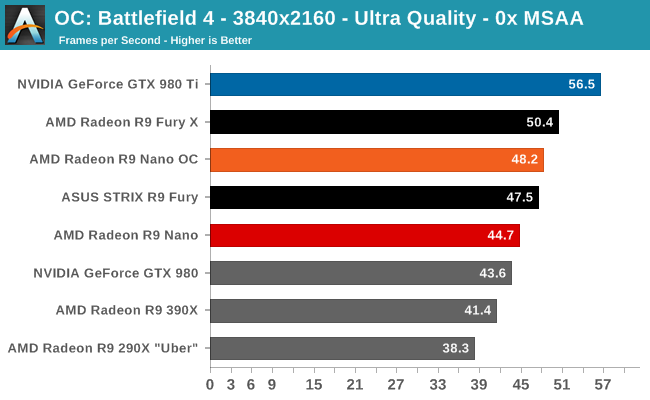

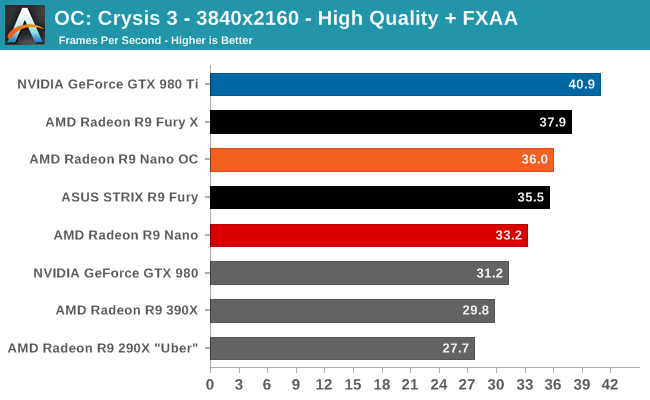
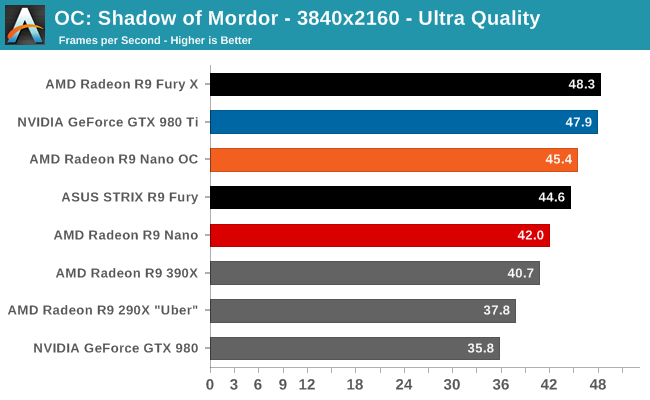
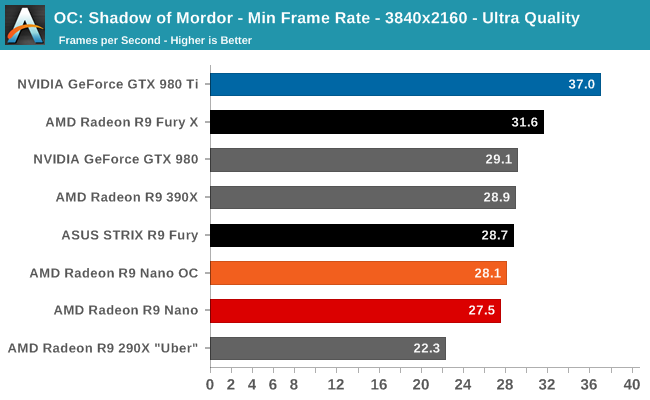
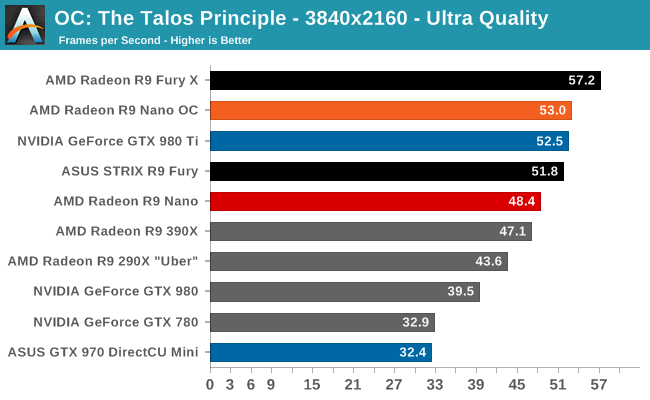
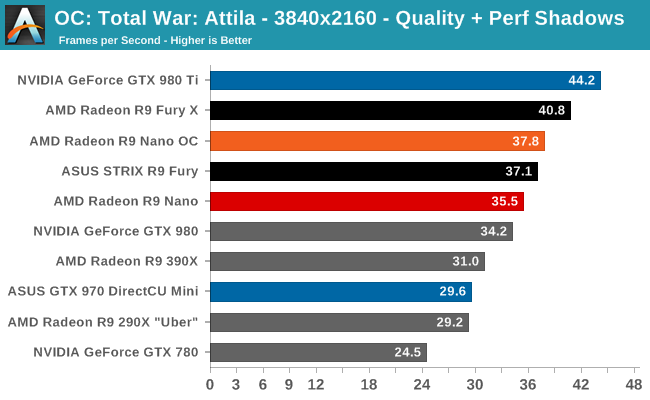
The overall performance gains from overclocking aren’t huge, but at 7-10% they also aren’t too shabby. However since higher clockspeeds quickly ramp up the power requirements due to the higher voltages required, the performance gains won’t be anywhere near the 35% increase in the power limit, despite that we are in fact still power limited.
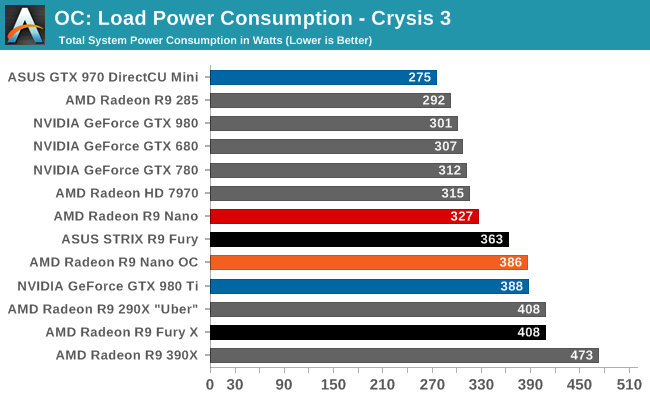
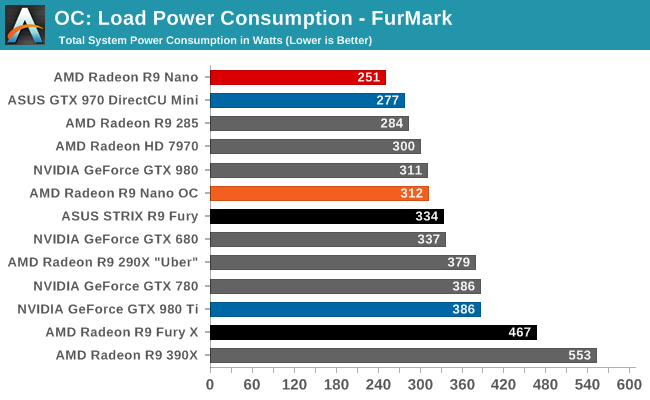
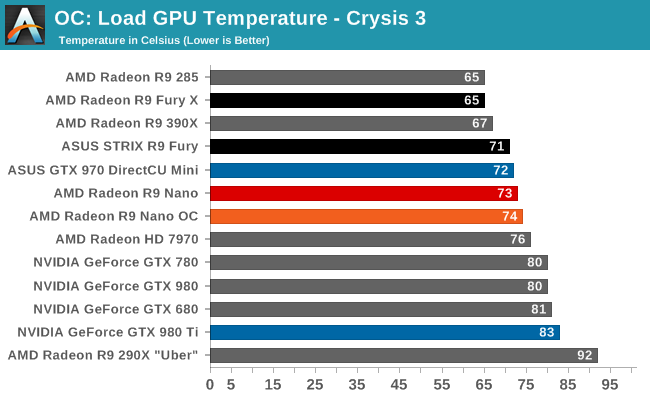
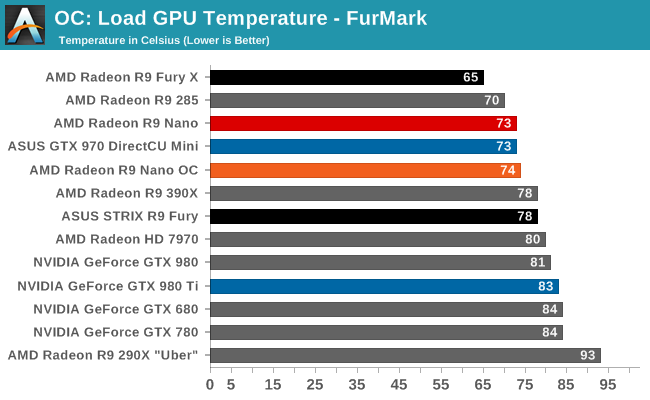
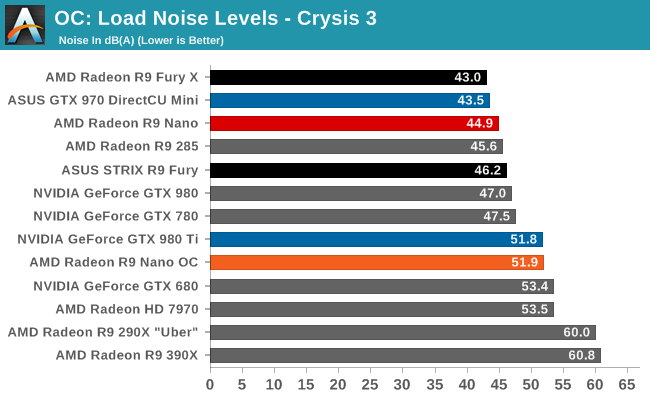
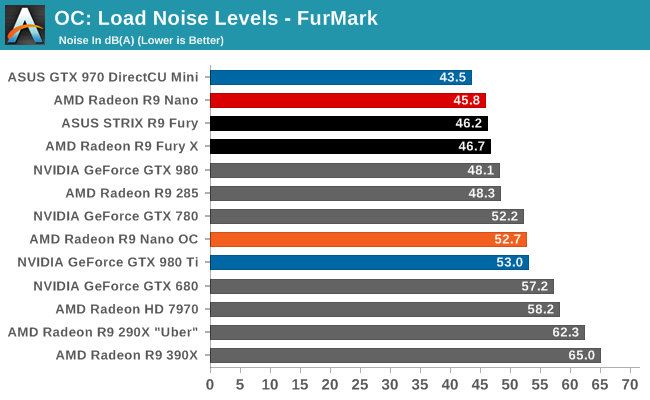
Meanwhile the 35% increase in the power limit has a definite knock-on effect on the cooling system. The R9 Nano’s cooler is able to keep up with the additional load, holding temperatures to 74C, but noise levels are now over 51dB(A). Power consumption at the wall is similarly affected, with the R9 Nano essentially giving up all of its energy efficiency gains in the process.










284 Comments
View All Comments
HOOfan 1 - Thursday, September 10, 2015 - link
Plenty of SFF cases fit full size cards now, unless you just have money burning holes in your pocket, why not buy one of those and get a regular non-X Fury or a 390X?przemo_li - Thursday, September 10, 2015 - link
ROTFL390X & 980 are TWICE as long.
That is SFF. Yeah, right. I will write SFF on my ITX tower. It will be so cool :P
trentchau - Thursday, September 10, 2015 - link
My Obsidian 250D is considered SFF (close to not being one) and it has a 980Ti in it. Why the laughter?HOOfan 1 - Thursday, September 10, 2015 - link
Fractal Node 202 will fit a GTX 980...are you going to tell me that is not small form factor?ingwe - Thursday, September 10, 2015 - link
For me there is a difference between a truly small form factor design and one that is "small form factor" but built to house a card twice as large as this. I am not saying this is an important distinction to everyone, but it is one that I would make. There is just a lot of size variability in mini-ITX cases.Your question though does really illustrate how much of a niche product this is though. You literally need to be going for the smallest package possible while retaining most of the performance--and not care about cost. It is an interesting product, but it is a mixed bag like the interview says.
tviceman - Thursday, September 10, 2015 - link
Clearly the Nano is a more interesting card to review but the obvious elephant in the room here is that Anandtech have completely dropped the ball on the last two major Nvidia releases (gtx 960 and gtx 950). Not only that, but you were also late with the Fury X review (being bed ridden can be a valid excuse but when deadlines are continually missed excuses run dry).Ryan you have great analysis, fair reviews, and strong writing. You've also had days, weeks (and months) to get reviews out (and on time) with the above mentioned cards and have failed to do so. You obviously need more help with reviews.
Oxford Guy - Thursday, September 10, 2015 - link
The 960 wasn't reviewed, most likely, because it was turkey.Gigaplex - Thursday, September 10, 2015 - link
How am I supposed to know it was turkey without either reading the review that doesn't exist, or buying one myself and being seriously disappointed? You don't just skip reviewing products that aren't very good, otherwise that defeats the point in reviews.K_Space - Friday, September 11, 2015 - link
@GigaplexI think Of is insinuating that Anandtech would not review a product that defaces nVidia (though I disagree). Getting the Nano review as a priority plus being chief editor (who probably proof reads other reviews), add in various administritive duties and it all takes its toll. The annual call up for reviewers has gone out recently; I think Anandtech made it clear enough they would love a helping hand in getting timely reviews... On time.
K_Space - Friday, September 11, 2015 - link
OG*